The Barracuda SecureEdge Manager allows you to configure an LDAP user directory. The user directory retrieves users and groups from multiple sources and syncs them into an LDAP user directory. Multiple user sources are available. The configuration steps required depend on the user directory you use.
Configure LDAP
To add an LDAP user directory:
Go to https://se.barracudanetworks.com and log in with your existing Barracuda Cloud Control account.
In the left menu, click the Tenants/Workspaces icon and select the workspace you want to configure the LDAP user directory for.
Go to Identity > Settings.

The Settings page opens. In the User Directories section, click Add User Directory.

From the user directory drop-down menu, select LDAP.
The Add User Directory page opens. Note: Ensure that the LDAP server is reachable from the internet.
In the User Directory tab, specify the values for the following:
Display Name – Create a display name to represent the user directory.
Host– Enter the host.
Port– Enter the port.
User Search Base – Enter user search base. E.g.,
dc=mydomain.com, dc=comGroup Search Base – Enter user search base. E.g.,
dc=mydomain.com, dc=comGroups Included – Enter the group to be included. To add more groups, click +. Note: For the group filter to work, you must provide the exact group name.
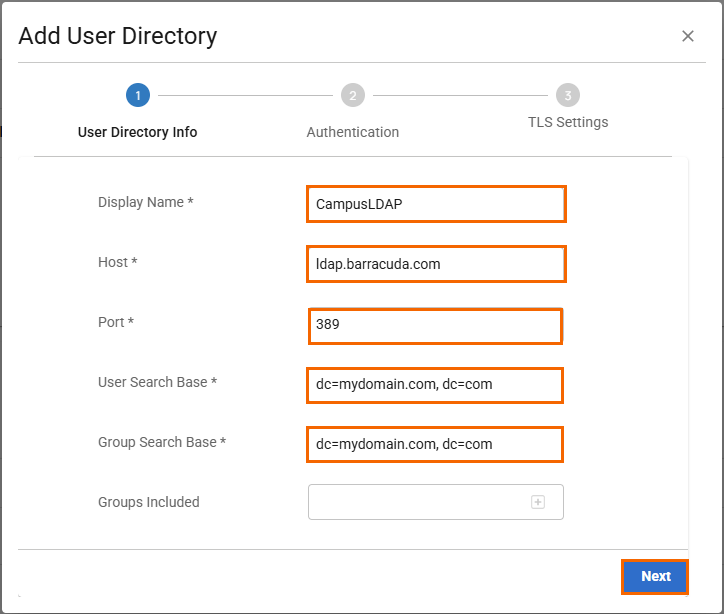
Click Next.
In the Authentication tab, specify the values for the following:
Authentication Method – Select Simple from the drop-down menu.
Username – Enter username.
Password – Enter password.
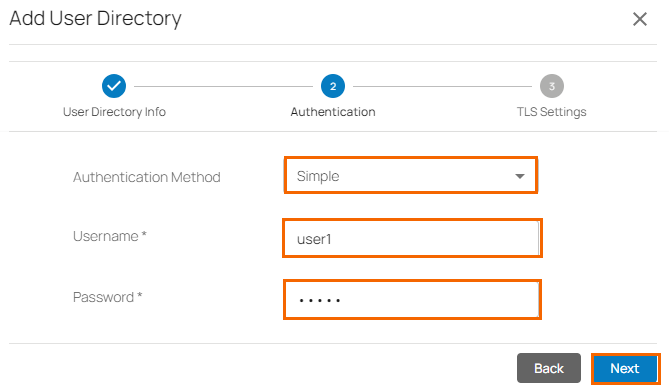
Click Next.
In the TLS Settings tab, specify the values for the following:
Encryption Method – Select encryption method from the drop-down menu. You can choose between None, StartTLS, and TLS.
If you select TLS, specify the following parameter:
CA Certificates – Upload your certificate.
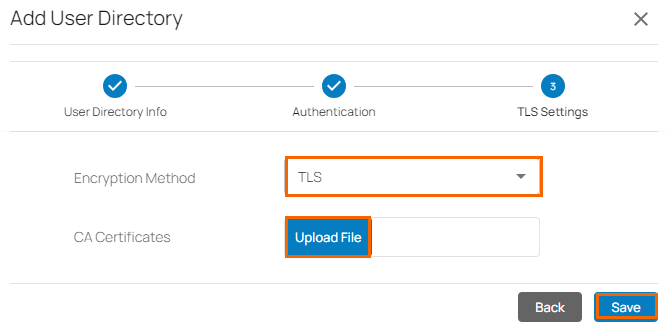
If you select StartTLS, there is no need to specify additional parameters.
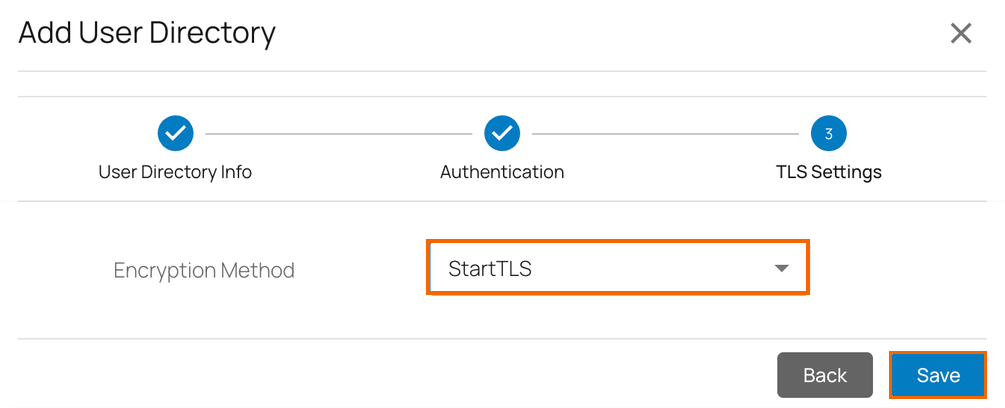
If you select None, there is no need to specify additional parameters. For example, in this case, select None.
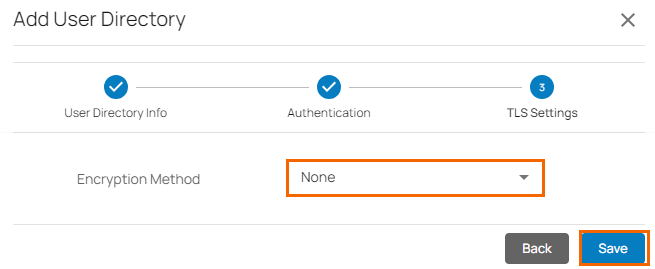
Click Save.
In the User Directories section, a new LDAP user directory has been added, and the STATUS is shown as Pending. The directory sync may take a few minutes.

After the directory sync is completed, verify that in the User Directories table, under the fieldname STATUS, the text has changed to Completed with a green check mark.

In addition, information under the fieldname LAST SYNC displays the time the last sync occurred. The field name SYNC RESULT displays the number of users or groups already synced. Verify that you see all LDAP directory users and groups on the respective Identity > Users and Identity > Groups pages.
Edit LDAP
To edit the LDAP user directory:
In the left menu, click the Tenants/Workspaces icon and select the workspace you want to edit the LDAP user directory for.
Go to Identity > Settings.
The Settings page opens. In the User Directories section, you can see that LDAP is displayed as your user directory.
To edit your LDAP account, click on the pencil icon.

The Edit User Directory page opens. Edit the value you are interested in. Note: All field names of LDAP user directory are editable.
Click Save.
Remove LDAP
To remove the LDAP directory associated with the selected workspace:
In the left menu, click the Tenants/Workspaces icon and select the workspace you want to remove the LDAP user directory for.
Go to Identity > Settings. The Settings page opens.
In the User Directories section, you can see your LDAP user directory is displayed.
To remove an existing LDAP user directory, click on the trash can icon.

The Delete User Directory <Name of Your User Directory> page opens.
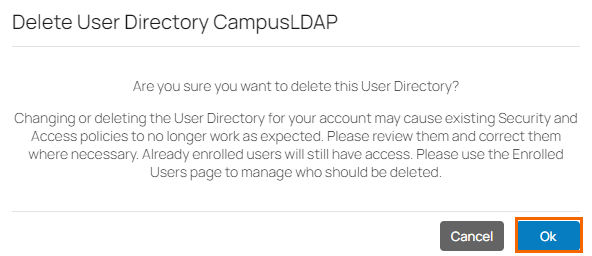
Click Ok to confirm.
You can verify the following:
You can verify that the previous users/groups from the LDAP user directory are not shown on the Identity > Users and Identity > Groups pages.
For your selected workspace, you can now configure a new user directory of your choice. You can verify that the users/groups from this new user directory are available in the security policies drop-down menu and are shown on the respective Identity > Users and Identity > Groups pages.
(Optional) Sync with LDAP
If you must sync the LDAP user directory quickly, proceed with the following steps:
On the Settings page, go to the User Directories section, and click the icon of three vertical dots to sync the user directory.
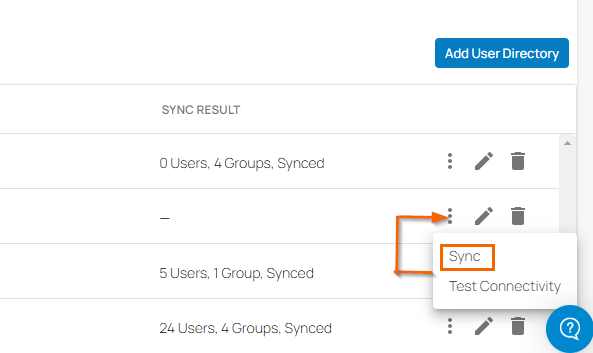
Click Sync.
The User Directory sync started pop-up window opens.
You will soon see that the sync has fetched and updated the users and groups in the identity management associated with the LDAP user directory. Verify that you see all LDAP directory users and groups on the Identity > Users and Identity > Groups pages after the successful sync.
(Optional) Test Connectivity
If you must test the connectivity of your LDAP user directory quickly, proceed with the following steps:
On the Settings page, go to the User Directories section, and click the icon of three vertical dots to test the connectivity of the user directory.
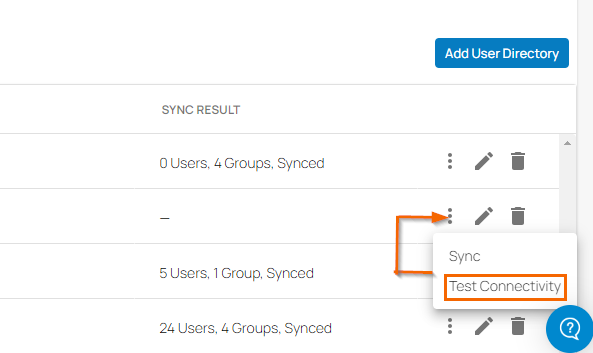
Click Test Connectivity.
The Testing <Name-of-Your-Directory> Connection pop-up window opens.
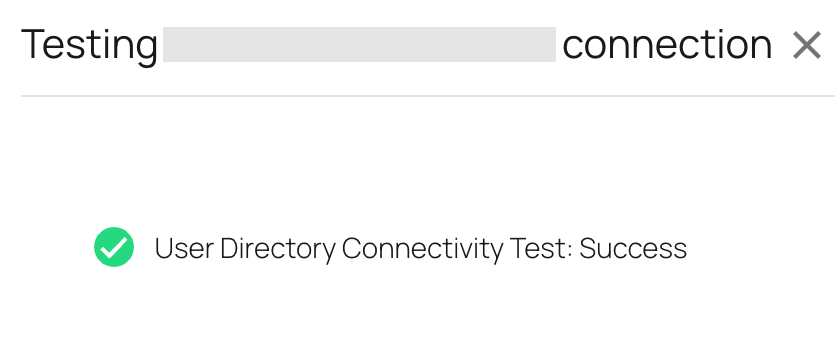
You can verify the status of your LDAP connection.
Further Information
For more information on how to verify LDAP users and groups, see How to Verify Identity Management Users and Groups.
For more information on how to connect your LDAP user directory with Barracuda Cloud Control, see LDAP Active Directory.
